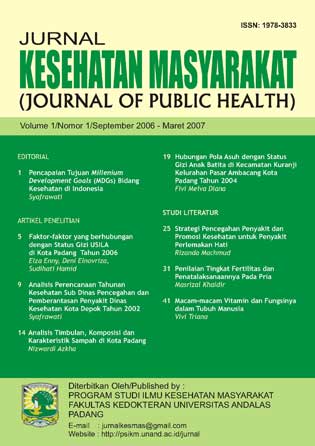Abstrak
There are still some household throw away garbage in promiscuoulsy place and not yet all garbage managed better by Padang government. The goal of this research for arise, composition and characteristics analysis garbage domestic in Padang City. The result of research for arise of garbage from domestic its avarage 2,26 l/p/days. The composition of garbage domestic consist of organic garbage 94,24% and anorganic garbage 5,75 %. For Physics cover to specific gravity (0,15 kg/l), size measure 250 mm (54,86%). For chemical to cover dampness (32%), volatil rate (58%), dusty rate (10%), C/N ratio (27,30) and enery content 7422 Btu/lb. For biology of size measure wearedby crowded fly of garbage during six hour obtained density of fly 7/ grill fly. For the planning of management of ideal garbage in Padang city, dissociating garbage start from home doorstep, need the existence of socialization in making of compost, and also management with sanitary landfill system or incenerator also still represent good enough alternative.
Authors who publish with this journal agree to the following terms:
- Authors retain copyright and grant the Andalas Journal of Public Health right of first publication with the work simultaneously licensed under a Creative Commons Attribution License (CC BY-SA 4.0) that allows others to share (copy and redistribute the material in any medium or format) and adapt (remix, transform, and build upon the material) the work for any purpose, even commercially with an acknowledgement of the work's authorship and initial publication in Andalas Journal of Public Health.
- Authors are able to enter into separate, additional contractual arrangements for the non-exclusive distribution of the journal's published version of the work (e.g., post it to an institutional repository or publish it in a book), with an acknowledgement of its initial publication in Andalas Journal of Public Health.
- Authors are permitted and encouraged to post their work online (e.g., in institutional repositories or on their website) prior to and during the submission process, as it can lead to productive exchanges, as well as earlier and greater citation of published work (See The Effect of Open Access).

